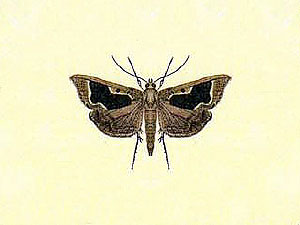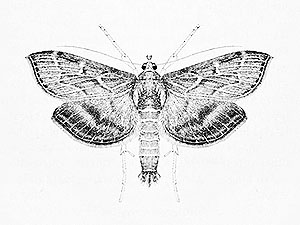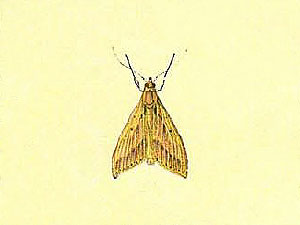Giffard’s Leaf-roller (Omiodes giffardi)
Giffard’s Leaf-roller was described in 1921, the species was restricted to the slopes of the Kilauea volcano on the island of Hawai’i, Hawaiian Islands.
The species reached a wingspan of about 2,5 cm.
The caterpillars fed on the native grass Ohe (Isachne distichophylla Munro ex Hillebr.). [1]
*********************
References:
[1] Elwood C. Zimmerman: Insects of Hawaii 8; Lepidoptera: Pyralidae. University of Hawaii Press, Honolulu 1958
*********************
edited: 23.09.2019
Tag Archives: Omiodes
Omiodes musicola Swezey
Maui Banana Moth (Omiodes musicola)
The Maui Banana Moth was described in 1909, the species was originally found somewhere in the forests of the ‘Iao Valley on western Maui, but was later also recorded from the neigboring island of Moloka’i.
The moth reached a wingspan of about 2,4.
The caterpillars are known to have fed on banana leaves, their native larval food plant appears to be unknown but may have been some grass species. [1]
*********************
References:
[1] Elwood C. Zimmerman: Insects of Hawaii 8; Lepidoptera: Pyralidae. University of Hawaii Press, Honolulu 1958
*********************
edited: 23.09.2019
Omiodes euryprora Meyrick
Olaa Banana Leaf-roller (Omiodes euryprora)
The Olaa Banana Leaf-roller was described in 1899, the species was found in the Ola’a rainforest on the island of Hawai’i, Hawaiian Islands
The moth reached a wingspan of about 2,5 cm.
The larvae were exclusively found on the leaves of banana plants, which however are not native to the Hawaiian Islands but were introduced to the islands only by the first Polynesian settlers. That means on the one hand, that the native larval host plant/plants is/are unknown, and on the other hand, that this species was able to adapt to new species of host plants.
It is possible that this moth species is not extinct, as it was thought for a long time. [1][2]
*********************
References:
[1] Elwood C. Zimmerman: Insects of Hawaii 8; Lepidoptera: Pyralidae. University of Hawaii Press, Honolulu 1958
[2] William P. Haines; Jon Giffin; David Foote: Rediscovery of five species of Omiodes Guenée (Lepidoptera: Crambidae) on Hawai’i Island. Bishop Occasional Papers 79: 45-49. 2003
*********************

(public domain)
*********************
edited: 23.09.2019
Omiodes epicentra Meyrick
Oahu Swamp Leaf-roller (Omiodes epicentra)
The Oahu Swamp Leaf-roller was described in 1899, the species inhabited swampy lowland areas on the northwestern coast of O’ahu, Hawaiian Islands.
The moth reached a wingspan of about 2 cm.
The The Oahu Swamp Leaf-roller already disapperaed at the beginning of the 20th century after the draining of its habitat for housebuilding. [1]
*********************
References:
[1] Elwood C. Zimmerman: Insects of Hawaii 8; Lepidoptera: Pyralidae. University of Hawaii Press, Honolulu 1958
*********************

(public domain)
*********************
edited: 23.09.2019
Omiodes meyricki Swezey
Meyrick’s Leaf-roller (Omiodes meyricki)
This species was described in 1904, it was found in the lowland rainforest around the Akaka falls near the northeastern coast of Hawai’i, Hawaiian Islands.
Meyrick’s Leaf-roller was one of several Hawaiian endemic leaf-roller species that were able to adapt to non-native host plants that had been brought by the first Polynesian settlers, its larvae fed on banana leafes. It is thus somewhat strange, at first glance, that these apparently quite adabtable moths disappeared during the early 20th century, but let’s just take a second look …:
In the late 19th, the early 20th century, and unfortunately up to this day, the Hawaiian Islands were and are merely considered by the American- and European settlers as some kind of tropical growing field for the production of cheap beef, coffee, pineapples etc.. The settlers not only brought new plants to the islands, they also unintentionally imported a lot of pest insects that spread all over the islands, thus it was thought to be the best to bring their natural enemies to the islands as well. However, some of them, like the two wasp species Cremastus flavoorbitalis (Cameron) and Trichogramma minutum Riley are anything but specialized to a single host, these two were alos found to parasitize the eggs of endemic moth species, including Meyrick’s Leaf-roller. [1]
*********************
References:
[1] Elwood C. Zimmerman: Insects of Hawaii 8; Lepidoptera: Pyralidae. University of Hawaii Press, Honolulu 1958
*********************

(public domain)
*********************
edited: 23.09.2019
Omiodes fullawayi Swezey
Fullaway’s Leaf-roller (Omiodes fullawayi)
Fullaway’s Leaf-roller was described in 1919, the species was apparently restricted to the Kona District on the western coast of Hawai’i, Hawaiian Islands.
The moth reached a wingspan of about 3 cm.
The larvae were known to feed on banana leaves. [1]
*********************
References:
[1] Elwood C. Zimmerman: Insects of Hawaii 8; Lepidoptera: Pyralidae. University of Hawaii Press, Honolulu 1958
*********************
edited: 23.09.2019
Omiodes telegrapha Meyrick
White-lined Leaf-roller (Omiodes telegrapha)
The White-lined Leaf-roller was described in 1899, the species is known only from the type specimen which had been collected somewhere in the Ola’a rainforest on the island of Hawai’i, Hawaiian Islands.
The species reached a winspan of about 3,8 cm. The under surfaces of the wings were strongly marked, much like the dorsum, the white scaling on the veins and the white apical lines between the veins are characteristic. [1]
*********************
References:
[1] Elwood C. Zimmerman: Insects of Hawaii 8; Lepidoptera: Pyralidae. University of Hawaii Press, Honolulu 1958
*********************

(public domain)
*********************
edited: 23.09.2019
Omiodes laysanensis Swezey
Laysan Leaf-roller (Omiodes laysanensis)
The Laysan Leaf-roller was described in 1913 (or 1914, according to other sources), the species is known only from the island of Laysan, Hawaiian Islands and is the sole known member of its genus known from the northwestern Hawaiian Islands.
The species reached a wingspan of 1,9 to 2,2 cm, the forewings were mainly light fuscous with a darker costa and median band, the hindwings were light fuscous, somewhat suffused with a whitish wash.
The biology of this species is not known, its larvae, however, are thought to have fed on some native grass species. [1][2]
*********************
References:
[1] Otto H. Swezey: Two new species of moths from Laysan Island. Proceedings of the Hawaiian Entomological Society 3: 18-19. 1913
[2] Elwood C. Zimmerman: Insects of Hawaii 8; Lepidoptera: Pyralidae. University of Hawaii Press, Honolulu 1958
*********************
edited: 25.09.2019
